The extended Disney Comics Universe is such a large, sprawling corpus of works (some originally not even meant to be in continuity with one another) that the existence of several continuity issues (which may or may not be easy to solve through more or less far-fetched theories) was inevitable. This page is a collection of such problems and possible solutions.
Duckburg Mythos
I - Huey, Dewey and Louie's Age
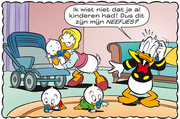
Impossibly young Huey, Dewey and Louie Duck in 1937, shown in Family Ties.
Even overlooking the Unaging Effect, there is an issue between Huey, Dewey and Louie Duck's first appearance in Donald's Nephews and the more in-depth look at the circumstances of their coming to live with Donald Duck in the 2014 story Family Ties. Donald's Nephews portrayal shows them as already being grown children in 1937 (the absolute youngest they could be would be three years old, allowing for precocity) during their first visit to Donald Duck, months before they are first seen perenially living with him. Meanwhile, Family Ties has the triplets asking Donald to tell them about Della because they don't remember anything about her, and, indeed, in the flashback Donald gives of Della giving them over to him, they're still babies, approximately one year old.
This problem can, however, be solved with a Broadstrokes attitude, by assuming that a largely similar chain of events where Huey, Dewey and Louie were already four in that scene (and in which they have slightly different motives for asking Donald about her) is the "true" version of events as far as the wider Duckverse is concerned.
II - The Golden Helmet
The Golden Helmet is thrown into the Canadian sea at the end of The Golden Helmet. Various stories brought the mesmerizing artifact back in contradictory ways. In The Lost Charts of Christopher Columbus (written in 1995 but meant to take place at some point prior to 1967), Azure Blue manages to fish the helmet out of the sea and once againt ries to claim America as his, only for the Helmet to turn out to be worthless when an older relic of a pre-Columbus discoverer of America arises.
In the 1989 story Enjoy the Golden Helmet, a direct sequel to The Golden Helmet that was not taken into account by Don Rosa in the writing of The Lost Charts of Christopher Columbus, Scrooge, fearing that Flintheart Glomgold track down the helmet, retrieves it from the sea and places it in a museum.
In the unrelated story Righftul Owners (written in 2010 but taking place around 1990), meanwhile, the Helmet is seen in Scrooge McDuck's private collection, where Huey, Dewey and Louie see it and ask how it got there, referring to the Helmet's disappearance in The Golden Helmet and remarking that Scrooge wasn't even there.
The best reconstruction of event seems to be that the helmet was lost in the sea for the first time in The Golden Helmet, fished out in the events of Lost Charts, then vengefully kicked back into the sea shortly after that story's closure, and in the absence of Scrooge — thus making the cryptic reference in Rightful Owners to that scene, which Huey, Dewey and Louie would have witnessed, rather than to the original Barks story. Scrooge would have fished out the Helmet as documented in Enjoy the Golden Helmet at some point prior. Of course, this leaves open the question of just why Huey, Dewey and Louie didn't remember the events of Enjoy, though considering how often the Ducks encounter magical or technological brainwashing techniques, it is not impossible to find an answer there.
lll - Grandma Duck's Name
The Duck Family matriarch Grandma Duck's real name is almost universally accepted as Elvira, a name which was popularized by Don Rosa but originated in this unnamed story: (https://inducks.org/story.php?c=W+WDC+121-04). However, in Ridin' the Rails, a 1955 story by Carl Fallberg, a central plot element of the story is that a mine is named after Grandma Duck, and that mine is called the Miss Abigail Mine.
Neverland Mythos
I - Peter Pan and Pixie Dust
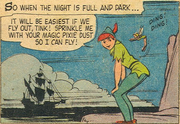
Peter being sprinkled with Pixie Dust in The Pirate Plot.
In the 1958 story The Pirate Plot, Peter Pan asks Tinker Bell to sprinkle him with Pixie Dust so he can fly. This is seemingly inconsistent with Peter's ability to fly freely in all other media, to the point that he didn't remember people needed Pixie Dust to do so in the 1953 film. (Peter Pan: The Legend of Neverland would later go on to hint that this was thanks to some magical bond between Peter and Tink, such that as long as Tinker Bell is healthy, Peter is capable of flight too.)
There is no satisfying explanation to this mistake; it is most probable, if something must be found, that the magical process undergone just prior to this story by Tinker Bell in The Wishing Well may have temporarily rendered the connection shown in Legend unstable.
II - The Crocodile's Whereabouts in the 1980's
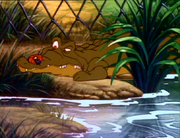
Tick-Tock in A Wolf in Cheap Clothing.
In Return to Neverland, in 1941, Captain Hook mentions that he "finally got rid of that blasted crocodile". This is consistent with the Tick-Tock Crocodile appearing in various media as no longer living in Neverland but instead various places on Earth, culminating with his being in a zoo in A Wolf in Cheap Clothing, all of which take place (or can be assumed to take place) at various points in the 20th century. However, the 1983 story Dugan in Neverland, wherein Dugan Duck travels to Neverland and meets Tick-Tock there, seemingly throws a wrench in the works, as A Wolf in Sheep's Clothing was created (and implicitly takes place) in 1989.
The best way to solve this conundrum is to assume that Dugan in Neverland, in a rare exception to the "release date <=> in-univers date" rule of thumb, actually takes place a few years later than its real-world release date, at the earliest in late 1989.
III - The Crocodile's Missing Ticking
Even in stories where he is unambiguously intended to be the same character, such as Mickey's House of Villains, the Tick-Tock Crocodile is sometimes depicted without his trademark ticking noise. The issue can easily be ignored (by assuming it is merely a quirk of the storytelling and the crocodile was "actually" ticking all along), or, alternately, it can be assumed that the clock, after all these years, does not work right outside of Neverland (as all the examples of its being omitted take place on Earth).
IV - Effects of Pixie Dust Removal
In the Disney Fairies series, Neverland pixies like Tinker Bell are shown to require a supply Pixie Dust to fly and work their magic, but otherwise suffer no ill effects from not having any beyond an inability to lift off the ground. By contrast, in Peter Pan: The Legend of Neverland, Tink becomes weak and her glow weakens when Captain Hook strips her of her Pixie Dust (something which eerily resembles the effect of someone saying they don't believe in fairies while in Neverland as seen in Return to Neverland), but on the other hand retains the ability to hover a little.
V - Timeline
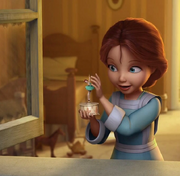
A supposedly 8-year-old Wendy Darling in Tinker Bell.
In the film Tinker Bell, which chronicles the birth and early life of the eponymous fairy, much of the plot hinges on a lost music box which washes up on the shore of Neverland and is found by Tinker Bell. At the end of the film, the music box is returned to its human owner on Earth, who turns out to be a young eight-year-old girl voiced by America Young, who is heavily implied to be a younger version of Wendy Darling from the Peter Pan feature film. Especially with the later Disney Fairies films taken into account, this is chronologically impossible, as the series takes place at least a whole decade, and more likely almost a century, before the events of Peter Pan.
The issue is best solved, as most do, by ignoring the Wendy connection and holding the Tinker Bell character to be a different, albeit similar, girl who lived decades before her Peter Pan counterpart. If one wishes to preserve a connection, it is possible that the girl would grow up to become the mother of Mary or George Darling, and thus the Peter Pan Wendy's grandmother.
VI - Ships and Pixie Dust
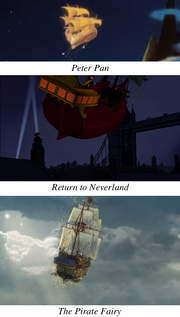
At the end of the 1953 Peter Pan, Tinker Bell covers the Jolly Roger in Pixie Dust to make it fly. This turns the entire ship the same golden color as pixie dust and Tink herself.
By contrast, when the Jolly Roger is once again made to fly with Pixie Dust in Return to Neverland, the ship flies but does not even leave the telltale trail of glitter characteristic of individuals flying with Pixie Dust.In The Pirate Fairy, a Dust-enabled flying ship is once again featured with yet another appearance, which leaves the ship its original color but with pixie dust clearly visible all around it, clinging to it.
The best explanation is that the visual effects reflect how much pixie dust was used. The Pirate Fairy flying ship was created by Zarina, and it was the first time such a feat had been attempted, explaining the somewhat heavy dosage that resulted in extra Pixie Dust; in Peter Pan, it is the first time Tinker Bell tries to make a ship fly, and knowing her usual personality it is quite understandable she would go overboard to the point of covering the whole ship in dust (hence the golden color); by the time of Return to Neverland, where Tink is also responsible, she would presumably have a better grip of how much Dust to use.
